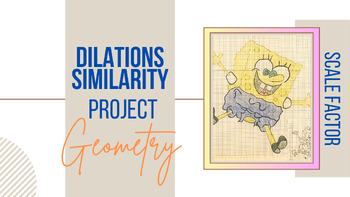Geometry Dilations Cartoon/Logo Project for Similarity Unit
- PDF
Description
This dilations project is a fun way to apply similarity and transformations in Geometry or Art. Students start by choosing a cartoon or logo that they would like to make a bigger version of! Students print and then trace their cartoon onto graph paper. They assign points to the tracing and record them. The number of points they choose can be up to you and them. Pick enough key corner points to allow for connecting the dots and preserving the image, or choose many points to ensure the exact replica of the image. Next students determine an appropriate scale factor so that their cartoon will fill a couple of adjacent pieces of graph paper. You can choose to have them fill 2 pieces of graph paper vertically or horizontally, or expand onto 4 pieces depending on the general shape of their picture, whether elongated, or more square. Students use this scale factor to multiply all of their points, dilating them. They will gain a fundamental understanding about how a dilation produces a similar (and larger) image, expanding all distances proportionally. Students will bring their design to life with color in the end!
Younger students can enjoy this project for the fun final product with some guidance. Older students can make more advanced designs and you may add a component where they describe their procedure for creating their project so that they show their understanding of similarity and dilations and the precision required to create a design that is a perfect duplicate. This is a good opportunity to consider dilations in the real world in things like marketing, billboards, a movie on the big screen, zooming on a phone, using photo editors and more.
As you will see in the included samples of student work, I often had them mount their final product to a large sheet of construction paper, add a title, include their original cartoon and small graph, and a write-up of their process. Another option I've used for displaying student work is to have them post in a shared google slides presentation where each student gets a slide for their work. This works especially well if you have a virtual class, or would just prefer a digital display.
INCLUDED:
- Project description
- Scoring rubric
- Graph paper - NOTE: to connect multiple pages together, have students cut an edge and tape on the back.
- Samples of student projects
I have done this project during a similarity or transformations unit, and also at the end of a school year when we did not have exams. Ending with projects can be a fun way to celebrate!
CHECK OUT THESE OTHER FUN GEOMETRY PROJECTS!
Geometry can be so visual, I love doing one in almost every unit!
BASIC VOCABULARY Logo Design Project
LOGIC Calculator Coding Project
CONSTRUCTIONS Treasure Hunt Project w/Points of Concurrency
TRIANGLE CONGRUENCE Origami "Geometree" Project
PYTHAGOREAN THEOREM Pythagorean Spiral
TRANSFORMATIONS Travel Poster/Video Project w/Canva
TRANSFORMATIONS Tessellations Project
CIRCLES "Stained Glass" Project





